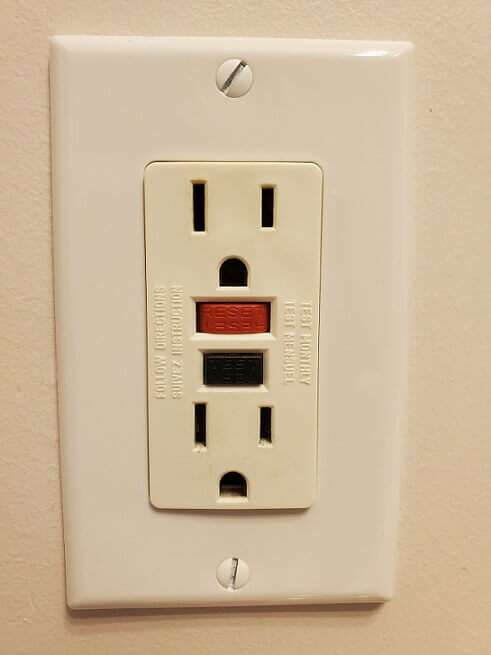The Types of Electrical Outlets
Before exploring common outlet repair problems, let’s review the types of outlets in your home.
USB Outlets
USB outlets help save time and space in homes with a smaller footprint by allowing you to plug in multiple devices simultaneously.
GFCI Outlets
GFCIs (Ground Fault Circuit Interrupters) are one of the safest forms of electrical outlet and help prevent electrical shocks by cutting off power to the outlet when a rapid change in voltage is detected.
Recessed Outlets
Recessed outlets are a design option for homeowners who wish to place furniture flush against a wall without cords and outlet covers in the way.
WiFi Outlets
Wi-Fi outlets allow you to control the flow of electricity from the outlet to connected devices via your Wi-Fi-enabled devices.
Tamper-Resistant Outlets
Tamper-resistant outlets feature built-in safety shutters that block foreign objects from being inserted into the receptacle. Since 2008, the National Electrical Code has required tamper-resistant outlets in any new build or renovation project.
Common Outlet Repair Issues and Their Causes
Problem: Outlet Has No Power
You go to plug in your cell phone charger and discover an outlet has no power and your device is not receiving a charge. To test whether the problem is with your outlet, device or charger, plug your device into another outlet. If it charges, test the initial outlet by plugging in other appliances.
Cause: Wall Switch is Turned Off
The reason your outlet is not providing power might be that it’s connected to a turned off wall switch. Before calling for help from a licensed electrician, check all connected switches are in the on position to rule out this cause.
Cause: GFCI Needs to be Reset
Ground fault circuit interrupters are becoming more common in homes across the U.S. They feature a reset button, which, when pressed, resets the circuit after it’s been tripped. Press the reset button on the front of the GFCI to see if it restores power to the outlet.
Cause: Wiring is Loose
Over time, the wiring connections behind the outlet may become loose due to structural shifting, insulation breakdown, and other environmental factors. If you’ve tried a GFCI reset and checked your wall switches are on, call an electrician to check for loose wiring connections.
Electricians can tighten the connections and then test your outlet. At this stage, they may look into further wiring problems if tightening loose connections doesn’t fix the problem.
Problem: Breaker Trips When Using an Outlet
If your breaker continually trips and causes a power loss when using a particular outlet, the issue is likely a power overload with too much demand on the connected electrical panel. Below are some of the causes behind persistent breaker trips:
Cause: Too Many Items Plugged In
Plugging in several appliances to the same outlet can exceed the voltage rating for that outlet and lead to a tripped breaker. Unplug several appliances and try the outlet again to see if the outlet works. Speak with an electrician if you unplugged devices and the outlet still trips regularly.
Cause: Arc Fault or Ground Fault
A persistently tripping breaker connected to a GFCI could result from a hot wire within the circuit contacting a ground wire. There may also be a loose wire leaking electricity behind the outlet. If you suspect a ground fault, call an emergency electrician immediately because the fault within the circuit may cause an electrical fire and represents a significant electrical hazard.
Cause: Short Circuit
When a non-GFCI outlet trips, the problem might relate to a short circuit with the electricity not following the intended path. Usually, you’ll notice other signs of an electrical fault in the impacted home area, for example, flickering lights.
Problem: The Outlet is Loose in the Wall
When you plug in your device and notice the outlet moves, you may have an electrical safety problem that requires an inspection. The most common causes for a loose outlet include:
Cause: Contact Points in the Receptacle Are Loose
When the outlet face plate is secure, but the plug is not tight within the socket, the contact points in your receptacle are probably loose. Worn contact points can potentially cause an electrical arc and fire hazard. Have a licensed electrician inspect the outlet to confirm a problem with the contact points.
Cause: Loose Outlet Face
A cracked or loose outlet faceplate may expose the wiring and cause the electrical connections to shift each time your family uses the outlet.
Outlet faceplates stay in place with screws, which you can tighten. However, you should call an electrician before taking on this task, as there may be other electrical concerns (such as exposed wiring) that make tightening and screwing in the faceplate further a potential electrical hazard.
Book Outlet Repair, Installation, and Wiring Services in Greater Des Moines
Custom Electrical Services serves homeowners and business owners throughout Greater Des Moines and Central Iowa with outlet installation, repair, and wiring services. You can call our licensed electricians any time, 24/7, for your outlet requirements.
Don’t attempt any outlet repairs without contacting our electricians first! Call 515-669-3418 to speak with our team!



